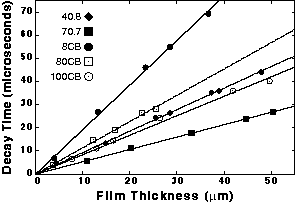
Dynamic Scattering of Coherent Soft X Rays
The coherent light emitted by a laser can be used to measure dynamic phenomena such as the Brownian motion of small particles. Analogous studies of molecular-scale motion, however, require shorter-wavelength light in the soft x-ray range. At Beamline 7.0.1, researchers used a double-pinhole coherence filter to convert the undulator beam into a highly coherent incident beam capable of measuring molecular fluctuations with 44-angstrom spatial resolution and 1-microsecond time resolution. Eventually, this technique might be used to probe molecular fluctuations during phase transitions and to study the internal motions of biological molecules. As a first step, the technique was successfully applied to a simpler problem: measuring the layer fluctuations of freely suspended liquid-crystal films.

In this experiment, the molecules of the liquid-crystal film were free to move within layers, as indicated by the illustration above (the separations between the layers and between the molecules have been exaggerated for clarity). Analysis of the intensity of the light reflected from such a fluctuating system yields a characteristic decay time for a given film thickness. A plot of decay time vs. film thickness (below) for five types of liquid crystals shows obvious linearity, in excellent agreement with the predictions of theoretical models. With future access to the unfiltered undulator light at Beamline 9.0.1 and suitable technique and source improvements, the researchers hope to eventually be able to produce x-ray movies of molecular motion.

Research conducted by A.C. Price and L.B. Sorenson (University of Washington, Seattle); S.D. Kevan and J. Toner (University of Oregon); and A. Poniewierski and R. Holyst (Polish Academy of Sciences), using Beamline 7.0.1.
Funding: U. S. Department of Energy, Office of Basic Energy Sciences; American Chemical Society Petroleum Research Fund; University of Washington Molecular Biophysics Training Grant; KBN Grants; and Maria Sklodowska Curie Joint Fund II.
Publication about this experiment: A.C. Price et al., Phys. Rev. Lett. 82, 755 (1999).
ALSNews article about this science highlight
More ALS Science